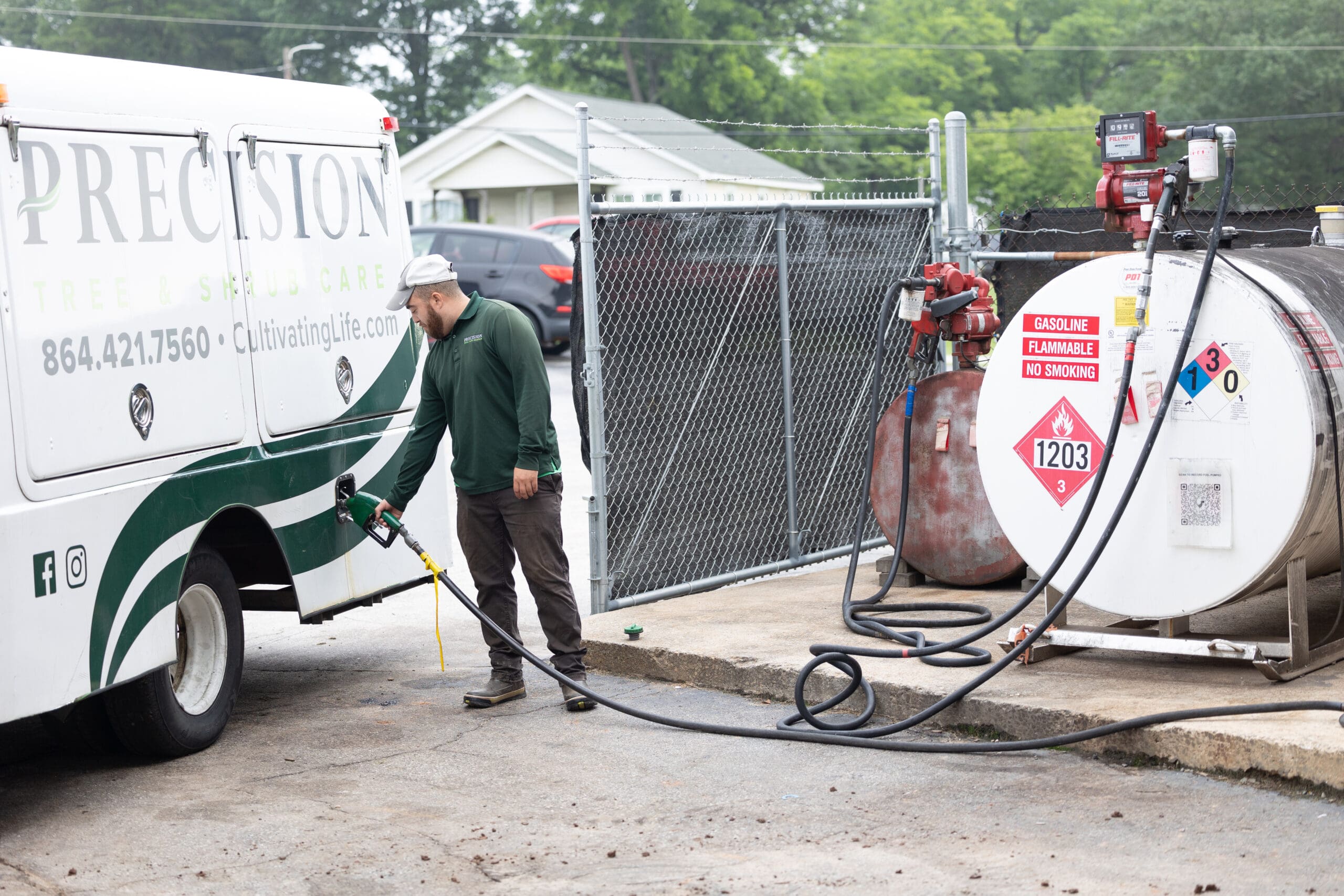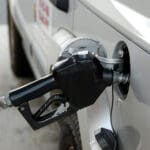
So, you’ve decided it’s time to add on-site fueling to your company headquarters and/or branch locations.
Hopefully, you’ve already thought through all the benefits and drawbacks having your own fuel tanks can offer your lawn and landscape business. Check out some of the other considerations to have in mind as you plan out this addition for increased efficiency.
Permitting and Safety
The necessary permitting and approvals needed will vary greatly depending on your location. Will Dutton, director of workforce safety and training for Russell Landscape Group, based in Sugar Hill, Georgia, says in their case, permits are required for tanks over 500 gallons.
Chris Lee, president of EarthWorks, based in Lillian, Texas, says that in their state, the Texas National Resource Commission approves the addition, and the local fire marshal also has to sign off on it. He says it was basically a matter of calling the involved agencies and finding out what they needed to do.
Ben Curtis, COO of Outerland, based in Mashpee, Massachusetts, says installing their tanks was relatively painless. They simply had to coordinate with their local fire department to make sure everything was squared away.
Vendors can also be helpful with navigating the different regulations and EPA inspections required before the tanks are installed.
Some of the common safety requirements for having a fuel tank on-site include concrete blockades around the tank, double walls to catch leaks, chemical absorbing mats, and having fire extinguishers and spill kits nearby.
Nate Moses, CEO of Precision Landscape Management, based in Greenville, South Carolina, says many of the protections needed are common sense and you should have a plan in place for dealing with spills.
Property Layout
When determining your fuel tank’s placement, consider its proximity to sensitive areas and access to a power source.
“It is important for the above-ground tanks to ensure an electrician sets up the power source,” Curtis says. “We learned the hard way that the pumps require a heavy gauge extension cord to ensure the draw can keep up with the pump. If not, you end up burning out the pumps and having to replace them. If I had done it differently, I would have had an electrician wire in an outdoor GFI that I could plug directly into without having to run an extension cord.”
You’ll also need to decide the ideal route through your property for crews to fuel up and park or exit the site, depending on whether you want employees to fuel up in the afternoon or morning. Lee adds that it’s not easy to move your fuel tanks once the infrastructure is in place.
Curtis says they placed two 1,000-gallon fuel tanks on either end of the property so multiple trucks fuel up at the same time. He says they also wanted to make sure no one has to back up to the gas pump. Their traffic flow allows crews to pull directly into their parking spots.
Dutton notes if you only have one pump, having 20 trucks fuel up may not result in the time savings you were looking for.
Selecting Your Vendor
A big step that can be overlook is selecting the right fuel distributor. Lee and Curtis stress the importance of finding one that is reliable.
“Will they leave you hanging if you run out of fuel?” Curtis says. “Then all of a sudden when you were supposed to be fueling at the shop, you got to send 25 trucks to a local gas station because something hasn’t gone right. That would be pretty annoying.”
Lee says no matter who you choose to work with, mistakes will happen, but how the vendor handles those problems is key.
“Are they accepting of responsibility?” Lee says. “Do they make it right? Do they do whatever it takes when they spill 100 gallons of fuel? Do they have a team out here with hazmat stuff and oil absorb everywhere? If yes, then great. That’s the kind of partner we’re looking for.”
Lee says cultivating a relationship with your distributor enables you to request special favors from time to time. For instance, Lee says when they know hurricanes in the Gulf are going to impact refinery production, they’ll ask to have their fuel tanks topped off ahead of schedule so their fuel supply isn’t disrupted.
Depending on the size of your fleet will determine how frequently your vendor will need to come out and refuel. Fuel distributors utilize smart monitors in the tanks to know when it’s time to make a delivery.
Edward Coady, CEO of Mainely Grass, based in Bedford, New Hampshire, says their tanks are refueled every two weeks or so, while Dutton says their tanks are refilled daily or every other day for their Sugar Hill location.
Cost
What vendor you choose to go with will greatly impact the cost of having your gas pumps installed.
“The company we’re working with right now makes all that easy for us,” Moses says. “They actually own the tanks and the pumps, and they don’t charge us anything for them. We have a total of, I think, eight fuel tanks, and we own maybe three or four of them, but they own the new ones. They don’t charge us anything. They just come fill them up.”
Coady says they decided to rent fuel cubes and pay a monthly rate as they only need the cubes for seven months.
Curtis says they opted for a lease-to-buy situation where the distributor installed the tanks at no cost while Outerland installed the concrete barriers. He says they’ll have the tanks paid off in three years.
Lee cautions going all-in with one vendor providing your fuel tanks.
“If you marry yourself to a distributor, they will typically provide all that stuff for you at no cost or a cheap lease,” Lee says. “But then you have no choice but to buy fuel from them period, end of story.”
Lee says if you ever get frustrated with your distributor and want to change – then it becomes a process of draining the tanks, having them removed, installing new tanks and refilling them.
“One thing I would highly recommend is buy your own tanks,” Lee says. “Figure out a way to do it so that you’re not trapped because it gives you a ton more leverage.”
Lee says instead of dealing with a distributor who is constantly late with deliveries you can look for another provider. EarthWorks’ recent fuel tank they bought was a 4,000-gallon tank for about $15,000 to $16,000. Lee says the pumps were $600 to $800 a piece and the biggest expense outside of the tank is running all the electrical.
Security Measures
Fencing, surveillance cameras and locking access to the fuel pumps are all common ways to prevent fuel theft. Curtis encourages putting fencing around the tank in particular so your property doesn’t look like a soft target you can easily walk up to and fill up your vehicle.
To help mitigate the risk of theft, EarthWorks has a dedicated crew that does all the loading, unloading and fueling of their trucks. The fuel tanks are located in the back half of the facility so no one has access to that part of the facility beyond that specific crew.
Dutton says they restrict access to the pumps by requiring a FuelCloud password.
Operational Impact
Changing how your company rolls out in the morning can result in on-site fueling being poorly received, especially if your crews are accustomed to getting breakfast at the gas station while they fuel up.
“The cleaner the process is for them to make that transition and the clearer it’s communicated, the more buy-in and the faster you’re going to be able to move to a more efficient system, quite frankly,” Curtis says.
It takes diligence to adapt to the new system.
“Like any management thing, if you see it and you let it go, then it’s an accepted behavior and then it’s going to be harder to change the pattern,” Curtis says. “Those are the little things that we have to keep up with but two years in, we’re in a really good spot.”
One major logistical decision you’ll have to make is when you want your crews fueling up. Depending on the number of pumps and tanks on your site will help determine how traffic should flow on the property.
Coady and Dutton opt to have crews fuel up at the beginning and the end of the day to eliminate bottlenecks.
Outerland and EarthWorks’ crews fuel in the evenings so they are ready to go in the morning. Curtis says logistically, the end of the day has always made more sense for them than moving the vehicles around in the morning before they roll out.
“I wouldn’t hesitate,” Lee says. “There’s really been no downside. It’s something that you have to learn to manage but is like anything else once you get that system down.”




